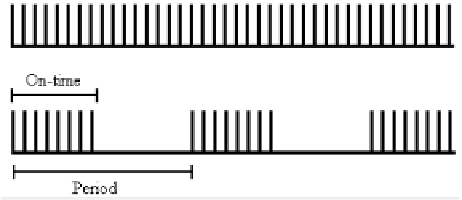Biomedical Engineering Reference
In-Depth Information
but may also involve the upper body via FES-assisted wrist exercise (Hartkopp,
2003) or arm cycling for tetraplegics (Gollee, 2002). The large muscle mass of the
legs however implies that FES leg exercise has greater potential than voluntary
arm exercise to train and improve cardiovascular fitness (Shephard, 1988; Haen-
nel, 1992; Glaser 1994; Davis, 2008). The exercise performed during electrical
stimulation can be as simple as isometric contractions through to more complex
movements like leg raises (Hillegass, 1999), leg cycling (Fitzwater, 2002) or the
lower-body component of rowing (Laskin, 1993).
The output of muscle stimulation using FES could be altered by modulating
the current parameters, employing either monophasic or biphasic waveforms,
current intensity, frequency, pulse duration and pulse train to elicit varied muscle
contraction responses (Kralj, 1989).
7.3.1 Stimulation Waveforms
muscle contractions. At a pulse frequency above 10-20 Hz in humans, the muscle
fibre twitches (40-100 msec) begin to overlap and summate forming an extended
muscle contraction (Baker, 2000). Increasing the pulse frequency further causes
greater overlap and earlier force summation, until the individual twitches are
completely fused into one smooth tetanic contraction. Tetanic summation depends
upon the fibre characteristics of a particular muscle, but for de-efferented muscles
it usually occurs at about 40 Hz pulse frequency (Shields, 1997; Gerrits, 2002).
By adjusting the stimulation frequency (i.e. frequency modulation), between
the fusion and the tetanus frequencies, the summation of fibre twitches and the
resulting force can be modulated (Crago, 1980).
7.3.2 Pulse Frequency
During continuous stimulation, fatigue increases with higher stimulation fre-
quency (Jones, 1979; Carroll, 1989; Hepple, 2003). There has been debate over
whether the rate of fatigue is directly related to the frequency, the absolute number
of pulses delivered (Marsden, 1983), both the frequency and the total number of
Figure 7.1
Continuous stimulation (top panel) and intermittent stimulation (bottom
panel). For intermittent stimulation the duty cycle is equal to the on-time divided by the
period.

















